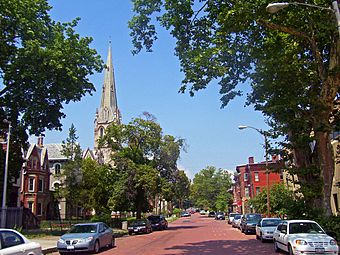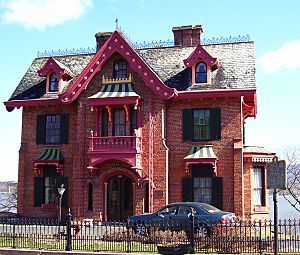Montgomery–Grand–Liberty Streets Historic District facts for kids
Quick facts for kids |
|
|
Montgomery–Grand–Liberty Streets
Historic District |
|

Looking north on Liberty Street, 2007
|
|
| Location | Newburgh, NY |
|---|---|
| Area | 1,010 acres (4.1 km2) |
| Built | 19th century |
| NRHP reference No. | 73001246 |
| Added to NRHP | 1973 |
The Montgomery–Grand–Liberty Streets historic district is a special area in Newburgh, New York. It was the first historic district created in the city. This district covers three main streets: Montgomery, Grand, and Liberty. These streets run north to south in the northeast part of Newburgh.
This historic area includes about 250 buildings across 1,010 acres (4.1 km²). Many of these buildings are old homes from the 1800s. They were built by important local business owners. These homes offered amazing views of the Hudson River. Some of the designs were very new and exciting for their time. They were inspired by Andrew Jackson Downing, a famous architect from Newburgh. Because of its important buildings, the district was added to the National Register of Historic Places in 1973.
Some buildings in the district are extra special. The David Crawford House, Old Town Cemetery, and Newburgh's main post office are all listed separately on the National Register. The Dutch Reformed Church is even more important. It is recognized as a National Historic Landmark.
History of the Historic District
This historic district was created to protect old buildings. People in Newburgh who cared about history were worried. They saw that many old buildings were being torn down. This was happening because of a plan called "urban renewal."
For example, the Dutch Reformed Church was almost destroyed. It had been empty for nearly ten years. Before that, the Crawford House was almost knocked down to make a school parking lot. These close calls made people realize they needed to save Newburgh's history. So, the city, then the state, and finally the National Register recognized this district.
In 1977, the city council made the district much bigger. They renamed it the East End Historic District. This new district included places like Washington's Headquarters State Historic Site. The city also created rules to make sure new buildings looked right. They formed a group called the Architectural Review Commission. This group helps keep the district looking historic. In 1985, a smaller part of the East End district was also added to the National Register.
Some parts of the district have faced challenges. For example, Liberty Street used to have a cobblestone surface. Over the years, it was not taken care of very well. Utility companies often dug it up for repairs. Then, they would just cover it with asphalt. The city has tried to fix parts of the street. They want to restore the whole street, but it costs a lot of money.
Many homes in the northern parts of the district are being fixed up. New residents are moving in and making them beautiful again. This helps the area keep its original feel as a green, residential neighborhood.
Important Buildings in the District
The Montgomery–Grand–Liberty Streets Historic District has many important buildings. These are called "contributing properties." They help make the district special.
Here are some of the notable buildings:
- The W. E. Warren House: This house is a great example of the "villa-style" homes that Andrew Jackson Downing liked. It was designed by Calvert Vaux.
- The Orange County courthouse: Built in 1842, this courthouse was designed by Thornton Niven. It looks like another courthouse he designed in Goshen.
- The Selah Reeve House: This house has a special gambrel roof. It was famous in the 1700s because it was shown on a popular piece of kitchenware.
- Many of Newburgh's oldest churches are also found in this district.



